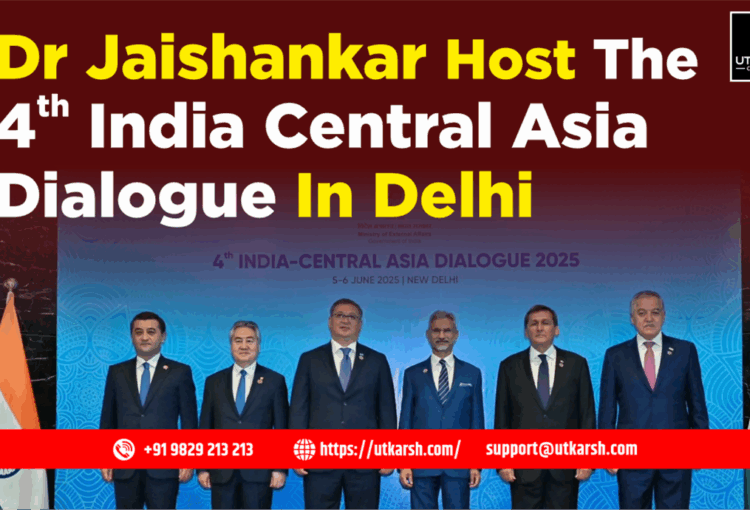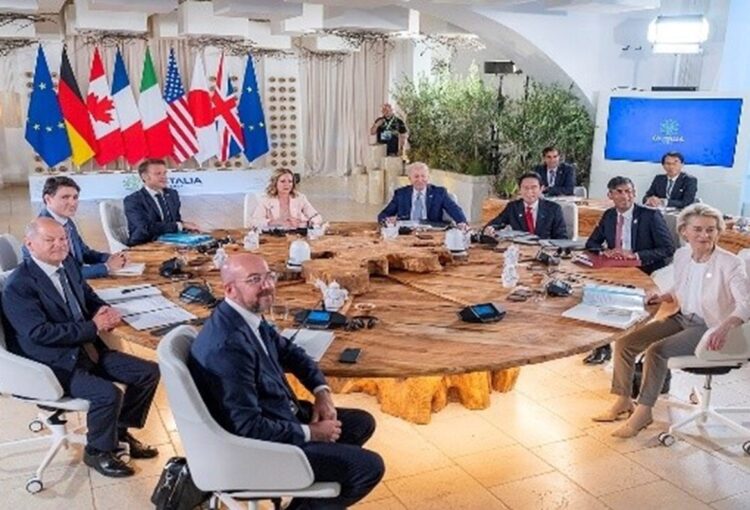4th India-Central Asia Dialogue
Syllabus: International Relations
- Hosted by: India (New Delhi) under the chairmanship of EAM Dr. S. Jaishankar
- Members: India, Kazakhstan, Kyrgyz Republic, Tajikistan, Turkmenistan, Uzbekistan
- Launched: 2019 (Samarkand)
- Objectives: Deepen cooperation in trade, energy, security, health, IT, and people-to-people ties; serve as a pillar for regional stability and sustainable development
- Key Outcomes: Counter-Terrorism – Condemned Pahalgam attack and called for adoption of the UN Comprehensive Convention on International Terrorism; Critical Minerals – Agreed to strengthen cooperation, with the 2nd India–Central Asia Rare Earth Forum planned; Connectivity – Emphasized increased use of Chabahar Port and INSTC, supporting inclusion of Uzbekistan and Turkmenistan; Digital & Financial Integration – Agreed on enhancing digital payment systems, interbank cooperation, and trade in national currencies; Health & Traditional Medicine – Focused on Universal Health Coverage, medical tourism, and traditional medicine collaboration; Clean Energy & Technology – Endorsed cooperation on India Stack, solar alliance, and biofuels; Global Role – Reaffirmed support for India’s permanent UNSC seat and enhanced role in SCO and UN.

- Challenges: Absence of direct land connectivity with Central Asia due to Pakistan’s denial of transit; Chinese infrastructure dominance via the BRI; instability in Afghanistan affecting connectivity and cooperation; underperforming trade volume (below $2B); regulatory and linguistic hurdles in bilateral execution
- Way Forward: Enhance Chabahar and INSTC utilization through the TIR Convention; foster digital governance collaboration using India Stack and DPI tools; accelerate critical mineral exploration and joint clean energy projects; expand academic, language, and cultural exchanges to build long-term soft power; regularize Joint Working Groups in priority areas like health, climate, fintech, and security
- Conclusion: India–Central Asia cooperation is anchored in deep civilizational ties and shared regional interests. Strategic focus on connectivity, digital infrastructure, and multilateral coordination will be vital to overcoming geopolitical barriers and building a resilient, mutually beneficial future.
Consider the following statements about India–Central Asia cooperation in critical minerals and rare earths:
- India and Central Asian countries have already signed a binding treaty for joint rare earth mineral extraction and processing.
- The India–Central Asia Rare Earth Forum is a recently established mechanism to facilitate investment and exploration in the sector.
- Central Asia is a net importer of critical minerals, especially lithium and cobalt, due to its lack of domestic reserves.
Which of the statements given above is/are correct?
A. 2 only
B. 1 and 3 only
C. 1 and 2 only
D. 1, 2 and 3
Answer:A
Explanation:
- Statement 1 is incorrect — no binding treaty has yet been signed; only joint interest has been expressed.
- Statement 2 is correct — the Rare Earth Forum is an outcome of the dialogue.
- Statement 3 is incorrect — Central Asia is rich in critical minerals such as uranium, rare earths, and other strategic resources, not a net importer.
Quantum Computing: Journey from bits to qubits
Syllabus: Science and Technology
- Quantum computing has gained global momentum with recent breakthroughs from Google, IBM, and China’s Jiuzhang, each demonstrating systems exceeding 100 qubits. Unlike classical computing, which uses bits that exist in binary states (0 or 1), quantum computing is based on the principles of quantum mechanics and uses qubits, which can exist in a superposition of states. This means a qubit can represent both 0 and 1 simultaneously, exponentially increasing computing potential. The concept was first proposed by Richard Feynman in 1981, envisioning machines capable of simulating quantum systems.
- The fundamental principles enabling quantum computing include superposition, entanglement, and quantum logic gates. Superposition allows qubits to hold multiple states simultaneously, such that a 100-qubit system can theoretically process 2¹⁰⁰ (~10³⁰) possible states. Entanglement enables qubits to be interlinked in such a way that the state of one qubit directly affects the state of another, regardless of distance—a phenomenon Einstein described as “spooky action at a distance.” Quantum gates manipulate these qubits to perform calculations within quantum circuits.
- Quantum computing holds transformative potential across sectors. In drug discovery and material science, it can simulate atomic and molecular interactions with unprecedented accuracy, as seen in collaborations like Pfizer and IBM. In logistics and optimization, it solves complex problems involving supply chains, traffic systems, and investment portfolios. In cybersecurity, quantum computing introduces quantum key distribution (QKD) for theoretically unbreakable encryption, while also threatening current encryption methods via Shor’s Algorithm. Additionally, quantum sensing applications extend to mineral detection, gravitational field mapping, and medical imaging.

- Significant progress has already been made. In 2019, Google’s Sycamore quantum processor achieved quantum supremacy by completing a task in 200 seconds that would take classical supercomputers approximately 10,000 years. IBM has developed quantum systems with over 100 qubits and aims to scale up to 1,000 qubits. China’s Jiuzhang system has achieved quantum advantage using photonic qubits. Startups such as IonQ and PsiQuantum are pioneering scalable quantum hardware using ion-trap and photonic technologies.
- However, the road to practical quantum computing is fraught with challenges. Decoherence remains a major issue, as qubits are highly unstable and collapse within fractions of a second due to environmental noise. Quantum error correction is another hurdle, requiring hundreds of physical qubits to create a single reliable logical qubit. Current systems with 100–200 physical qubits yield only around five usable logical qubits. Moreover, quantum infrastructure demands ultra-cold environments, precision control systems, and significant financial investment.
- Globally, nations are in a competitive race to lead in quantum technologies. China has invested approximately $15 billion, developing a national quantum network. The United States has committed over $4 billion, with companies like Google, IBM, and Microsoft leading private sector innovation. The European Union runs a €1 billion Quantum Flagship program, while the UK, Japan, and Canada are focusing on quantum-safe encryption and hybrid quantum-classical systems.
- India launched its National Quantum Mission in 2020 with a ₹8,000 crore outlay, placing it among the world’s top five quantum investors. Institutions such as the IITs, IISc, and TIFR are currently working on early-stage 5–10 qubit systems, with the goal of developing 50–100 qubit machines by 2030. Key focus areas include post-quantum cryptography, quantum sensors, and secure communication infrastructure.
- Looking ahead, fault-tolerant quantum computers with millions of qubits are expected to emerge by the 2040s. These systems are poised to complement classical computing in domains such as quantum simulations, decryption, and large-scale optimization. The global push now emphasizes developing quantum-safe digital infrastructure, fostering international R&D collaboration, and strengthening domestic capabilities.
- In conclusion, quantum computing marks a revolutionary shift with the power to reshape modern science, defence strategies, economic systems, and digital governance. India’s early strategic commitment, coupled with sustained funding and research, positions it as an emerging quantum power ready to lead in the transition from classical bits to quantum qubits.
Consider the following statements regarding quantum advantage and quantum supremacy:
- Quantum advantage refers to the stage where quantum computers outperform classical ones in at least one specific task.
- Quantum supremacy implies that quantum computers can solve all problems faster than classical supercomputers.
- Google’s Sycamore processor was the first to demonstrate quantum advantage.
Which of the above is/are correct?
A. 1 only
B. 1 and 3 only
C. 2 and 3 only
D. 1, 2 and 3
Answer:A
Explanation:
- Statement 1 is correct: Quantum advantage is when a quantum computer performs a task significantly better than any classical computer.
- Statement 2 is incorrect: Quantum supremacy does not imply universal superiority; it refers to one specific problem solved exponentially faster.
- Statement 3 is incorrect: Google’s Sycamore demonstrated quantum supremacy, not merely quantum advantage.
Zimbabwe Elephant Culling
Syllabus:Environment
- Context: Zimbabwe has authorized the culling of elephants in the Save Valley Conservancy due to unsustainable population levels and rising human-wildlife conflict.
Zimbabwe Elephant Culling – Key Highlights:
What’s Happening?
- Zimbabwe’s wildlife authority, ZimParks, has initiated the culling of 50 elephants in the Save Valley Conservancy. The sanctuary currently shelters around 2,550 elephants—more than triple its ecological carrying capacity of 800.
Why the Culling?
- Ecological Overload: The excessive elephant population is putting immense pressure on the reserve’s biodiversity and vegetation.
- Rising Human-Wildlife Conflict: Scarcity of food and water is driving elephants into human settlements, leading to increased encounters and damage.
- Relocation Challenges: Attempts to move the elephants have seen limited success—only 200 were relocated over a span of five years.
- Climate Stress: Ongoing droughts and climate change have intensified habitat degradation, limiting the natural resources available for wildlife.
- This move, though controversial, reflects the complex balance between conservation and community survival in climate-stressed ecosystems.
In light of Zimbabwe’s decision to cull elephants in the Save Valley Conservancy, consider the following statements regarding wildlife management and ecological principles:
- Elephant overpopulation in a closed ecosystem can lead to trophic cascade effects, altering species composition and ecosystem structure.
- Culling is considered a legally sanctioned conservation tool under the Convention on International Trade in Endangered Species of Wild Fauna and Flora (CITES).
- Relocation of megafauna like elephants is often preferred over culling due to its lower ecological disruption and cost-effectiveness.
- The carrying capacity of an ecosystem is fixed and unaffected by factors such as climate variability or anthropogenic pressures.
Which of the above statements are correct?
A. 1 and 2 only
B. 1 and 3 only
C. 2 and 4 only
D. 1, 2, and 3 only
Correct Answer: B. 1 and 3 only
Explanation:
- Statement 1 is correct. Overpopulation of a keystone species like elephants in a confined area can cause trophic cascades, leading to the degradation of vegetation, soil erosion, and collapse of food webs.
- Statement 2 is incorrect. CITES primarily governs international trade in endangered species and does not regulate domestic wildlife management practices such as culling.
- Statement 3 is correct. Although costly and operationally demanding, relocation is often preferred over culling from both ethical and ecological standpoints to preserve biodiversity.
- Statement 4 is incorrect. Carrying capacity is not a fixed value and varies depending on environmental conditions, such as rainfall, vegetation cover, and human-induced pressures like land-use change.
52nd G7 Summit
Syllabus:IR
- Context: The Prime Minister of India is set to attend the 52nd G7 Summit in Kananaskis, Canada, from June 15–17, 2025, at the invitation of the Canadian Prime Minister. India has been a special invitee to G7 summits since 2019.
About the 52nd G7 Summit:
- The Group of Seven (G7) is an informal intergovernmental coalition of the world’s most advanced and industrialized democracies. It serves as a high-level forum to deliberate on global economic governance, geopolitical challenges, and cross-cutting policy issues. It is not treaty-based and lacks a permanent secretariat, reflecting its flexible and consensus-driven nature.
- Formation and Membership: Established in 1975 as the Group of Six (France, Germany, Italy, Japan, the UK, and the USA). Canada joined in 1976, forming the G7. The European Union also participates as a non-member invitee. Russia was added in 1998 (forming the G8) but was suspended in 2014 following the annexation of Crimea, reverting the group to G7.
Evolution and Priorities:
- 1970s: Originated to manage the fallout of the global oil crisis and foster macroeconomic coordination among major economies.
1980s: Agenda broadened to include arms control, global security, and human rights.
2000s–present: Increased engagement with developing nations and focus on emerging global issues like climate change, digitalization, financial inclusion, and pandemic preparedness.

Core Functions of the G7:
- Macroeconomic Governance: Facilitates joint policy efforts to stabilize global markets, curb inflation, and ensure financial discipline.Global Crisis Response: Leads cooperative action on urgent transnational challenges such as climate resilience, public health emergencies, cybersecurity, and AI governance.
- Democratic and Developmental Agenda: Promotes liberal democratic values, inclusive growth, gender equality, and sustainable development across its own jurisdictions and developing partners.
- Donor Coordination and Global Signalling: Serves as a platform for policy alignment among leading donor countries and communicates global priorities to multilateral institutions like the UN, IMF, and World Bank.
- The 52nd G7 Summit is expected to underscore global cooperation on digital transitions, energy security, and the role of democracies in an increasingly multipolar world.
With reference to the evolution of the Group of Seven (G7), consider the following statements:
- The G7 originated in response to global financial fragmentation following the collapse of the Bretton Woods system.
- The G8 ceased to exist due to disagreements over nuclear non-proliferation and was replaced by the G20.
- The G7 Summit functions under a formal charter and legally binding decisions, similar to the UN General Assembly.
- The European Union participates in the G7 Summits as a full member with voting rights equal to other nations.
Which of the statements given above is/are correct?
A. 1 only
B. 1 and 4 only
C. 2 and 3 only
D. 1, 3, and 4 only
Answer: A. 1 only
Explanation:
- Statement 1 is correct: The G7 was formed in the aftermath of the 1973 oil crisis and collapse of the Bretton Woods system to coordinate economic policies.
- Statement 2 is incorrect: The G8 was effectively suspended due to Russia’s annexation of Crimea, not due to nuclear disagreements, and G20 was not formed as its replacement—it existed alongside.
- Statement 3 is incorrect: G7 is informal, lacks a charter or secretariat, and decisions are not legally binding.
- Statement 4 is incorrect: The EU is a participant but not a full member and has no voting rights.
National e-Vidhan Application (NeVA)
- Syllabus:Governance
- The Union Minister will inaugurate the National e-Vidhan Application (NeVA) for the Puducherry Legislative Assembly on 9th June 2025.
- About National e-Vidhan Application (NeVA)
- NeVA is a digital platform designed to enable the paperless conduct of legislative business across all State and Union Territory legislatures in India. It reflects the vision of ‘One Nation – One Application’ by integrating all legislative houses into a single interface.
- Developed and implemented by the Ministry of Parliamentary Affairs (MoPA), NeVA is supported by the Ministry of Electronics and Information Technology (MeitY) and powered by BHASHINI for AI-based translation services. The project was approved by the Public Investment Board on 15 January 2020 with a total cost of ₹673.94 crore, operating under a centrally sponsored scheme to ensure equitable support to states.
- The primary aim of NeVA is to digitize legislative proceedings and promote paperless functioning of legislative houses while creating a unified national repository for all legislative data.

Key features of NeVA include:
- End-to-end paperless functioning, facilitating the complete digital management of legislative business such as uploading agendas, bills, speeches, and responses.
- AI and machine learning-powered real-time translation through BHASHINI, enabling instant translation of speeches and documents into multiple Indian languages.
- A unified digital workspace that connects legislators, government departments, and assembly secretariats on one platform.
- Secure document management with multi-layered security protocols and searchable digital archives featuring role-based access control.
- Training modules and simplified workflows designed to provide hands-on training for MLAs and legislative staff to ensure seamless adoption of the system.
With reference to the National e-Vidhan Application (NeVA), consider the following statements:
- NeVA enables real-time multilingual translation using tools developed solely by the Ministry of Parliamentary Affairs.
- The funding model for NeVA is entirely borne by the Central Government for all States and Union Territories.
- NeVA aims to create a federated digital infrastructure rather than a centralized national platform.
- It aligns with the objectives of the Digital India Programme and promotes cooperative federalism in legislative governance.
Which of the statements given above are correct?
A. 1 and 3 only
B. 2 and 4 only
C. 3 and 4 only
D. 1, 2, and 4 only
Answer: C. 3 and 4 only
Explanation:
- Statement 1 is incorrect. NeVA uses BHASHINI, developed under MeitY, for AI-based translation—not solely by MoPA.
- Statement 2 is incorrect. NeVA follows a centrally sponsored model, not fully centrally funded; states share implementation costs.
- Statement 3 is correct. NeVA adopts a federated architecture to preserve legislative autonomy while enabling digital integration.
- Statement 4 is correct. It aligns with Digital India and strengthens cooperative federalism by integrating all Houses on a single platform.
12th BRICS Parliamentary Forum
Syllabus:Governance
Context:
- India has assumed the chairmanship of the 12th BRICS Parliamentary Forum, to be hosted in 2026. This follows the 11th Forum in Brazil, where BRICS parliaments jointly condemned the Pahalgam terror attack.
About the 12th BRICS Parliamentary Forum:
- The BRICS Parliamentary Forum is a multilateral dialogue platform that brings together the legislatures of BRICS countries to deliberate on global challenges and foster cooperative lawmaking. It facilitates discussions on counter-terrorism, artificial intelligence governance, economic coordination, and inter-parliamentary diplomacy.
Origin:
- The Forum was inaugurated in 2015 to function parallel to BRICS summits, enhancing democratic engagement and consensus-building among member legislatures.
Chairmanship:
- It rotates annually among member countries. India will hold the chair until the conclusion of the 12th Forum in 2026.
Objectives and Functions:
- To strengthen parliamentary diplomacy and legislative coordination on global issues. It seeks to promote collaborative lawmaking, democratic values, and unified responses to transnational challenges. The Forum amplifies the Global South’s voice in multilateral parliamentary governance and contributes to peace, security, and inclusive development through consensus.
About BRICS:
- BRICS is an intergovernmental grouping of 11 emerging economies, primarily representing the Global South. It aims to reshape global governance by promoting multilateralism, reforming global institutions, and fostering balanced development.
Establishment:
- The term “BRIC” was coined in 2001. Formal engagement began in 2006 through Foreign Ministers’ meetings, leading to the first summit in 2009 in Ekaterinburg, Russia.
Headquarters:
- BRICS does not have a permanent headquarters. Its chairmanship rotates annually.
Current Members (11):
- Original: Brazil, Russia, India, China, South Africa
New (joined in 2023–24): Egypt, Ethiopia, Iran, Indonesia, Saudi Arabia, United Arab Emirates (UAE)
Core Priorities:
- BRICS focuses on promoting inclusive economic growth, sustainable development, institutional reforms of global financial and security systems (UN, IMF, World Bank), and peaceful multilateralism. It supports cooperation in areas such as digital transformation, energy security, health, education, space research, fintech, artificial intelligence regulation, climate resilience, and food security.
- Under India’s leadership, the 12th BRICS Parliamentary Forum is expected to emphasize inclusive democratic engagement, multipolar global cooperation, and deeper integration of the Global South’s interests in international governance.
With reference to the BRICS Parliamentary Forum, consider the following statements:
- It was established as a legally binding parliamentary mechanism during the BRICS Summit in Ekaterinburg.
- The Forum’s core mandate includes facilitating collaborative lawmaking among member legislatures on transnational issues.
- It is chaired by the BRICS country holding the presidency of the BRICS Summit for the same year.
Which of the statements given above is/are correct?
A. 1 only
B. 2 and 3 only
C. 1 and 2 only
D. 2 only
Answer: D. 2 only
Explanation:
- Statement 1 is incorrect: The Forum is not a legally binding mechanism; it was inaugurated in 2015, and not during the 2009 Ekaterinburg Summit.
- Statement 2 is correct: The Forum facilitates collaborative lawmaking and democratic coordination on issues like AI, counter-terrorism, and economic governance.
- Statement 3 is incorrect: While both the Forum and Summit have rotational chairmanship, they do not necessarily coincide or follow the same cycle.
INS Arnala
Syllabus:Defence
- Context: The Indian Navy is set to commission INS Arnala, the first in a series of 16 indigenously developed Anti-Submarine Warfare Shallow Water Crafts (ASW-SWC), at Visakhapatnam.

INS Arnala – Overview
What is INS Arnala?
- INS Arnala is India’s first indigenous ASW-SWC vessel, aimed at boosting the Navy’s operational capability in coastal defence, sub-surface warfare, and mine-laying.
- Construction & Development:Developed by Garden Reach Shipbuilders & Engineers (GRSE), Kolkata, in collaboration with L&T Shipbuilders. Built under the “Make in India” initiative, it incorporates over 80% indigenous content from Indian firms including BEL, Mahindra Defence, MEIL, and L&T.
- Strategic Role and Deployment:Operates primarily in coastal waters and across the Indian Ocean Region (IOR). Suited for Low-Intensity Maritime Operations (LIMO), Search and Rescue (SAR) missions, and sub-surface surveillance.
- Arnala Fort – Historical BackdropLocation: Situated on an island off the coast of Arnala village, in Vasai taluka, Maharashtra, near Mumbai.
- Alternate Names: Also called Jaldurg or Janjire Arnala, it is surrounded by sea and exemplifies strategic maritime architecture.
- Historical Evolution:Originally constructed in 1516 by Sultan Mahmud Begda of Gujarat. Subsequently came under the control of Portuguese, Marathas, Mughals, and later the Peshwas.
- Architectural Highlights:Fort has a rectangular layout with three main entrances and multiple bastions. Temples dedicated to Tryambakeshwar, Bhavani Mata, Kalika Mata, and Mahadev lie within the premises. Despite the absence of food sources, freshwater wells within the fort reflect intelligent coastal design and sustainability.
- INS Arnala not only marks a technological milestone for India’s naval capabilities but also draws its name and spirit from a historically resilient maritime fort that once served as a coastal stronghold.
With reference to the INS Arnala, consider the following statements:
- It is the first Indian naval vessel to be equipped with both nuclear propulsion and waterjet-based engines.
- It has operational capabilities limited strictly to high-seas, with minimal utility in coastal operations.
- It integrates over 80% indigenous systems from Indian private and public sector defence firms.
Which of the statements given above is/are correct?
A. 1 and 2 only
B. 3 only
C. 2 and 3 only
D. 1, 2 and 3
Answer: B. 3 only
Explanation:
- Statement 1 is incorrect: INS Arnala is powered by a Diesel Engine–Waterjet propulsion system, not nuclear.
- Statement 2 is incorrect: It is specifically designed for shallow water and coastal operations.
- Statement 3 is correct: Over 80% of its systems are indigenously sourced
Starlink
Syllabus:Governance
Context:
- The Department of Telecommunications (DoT) has officially granted a license to Starlink, allowing it to offer satellite-based internet services in India. This makes Starlink the third authorized provider in the country after Eutelsat OneWeb and Jio Satellite Communications.
About Starlink:
- Starlink is a satellite internet service developed by SpaceX, an aerospace company founded by Elon Musk in 2002. It aims to deliver high-speed, low-latency internet access, particularly for rural and remote regions with limited digital infrastructure.

How Starlink Works:
- Starlink functions through a constellation of Low Earth Orbit (LEO) satellites positioned around 550 km above the Earth. Ground stations transmit data to these satellites, which then relay signals to user terminals via radio frequencies. Each satellite is also equipped with optical laser links, allowing inter-satellite communication and forming a global mesh network in space.
Key Features of Starlink:
- Starlink provides download speeds up to 150 Mbps, with plans for significant improvements in future phases. It achieves latencies as low as 20–25 milliseconds, suitable for high-demand applications like video conferencing and gaming. The satellites utilize advanced technologies, including argon-powered ion thrusters for propulsion and flat-panel phased-array antennas for signal transmission. SpaceX frequently launches new satellites using its Falcon 9 rockets to ensure redundancy and network expansion. The final network architecture is designed to include up to 42,000 LEO satellites to achieve seamless global coverage.
Significance of Starlink in India:
- Starlink’s entry is expected to significantly improve digital access in rural, tribal, and geographically challenging areas. It provides a robust alternative to terrestrial infrastructure, particularly valuable in disaster-prone zones. Its presence enhances competition in the broadband market, especially in underserved Tier-2 and Tier-3 cities. Strategically, it aligns India with global advancements in satellite communications and supports critical sectors such as defence, education, health, and emergency services.
With reference to the working of Starlink satellite internet, consider the following statements:
- Starlink satellites operate at Medium Earth Orbit (MEO) to ensure wider geographical coverage.
- Each satellite uses optical laser links to facilitate inter-satellite data relay without dependence on ground stations.
- User terminals on Earth communicate with satellites using microwave frequency bands.
Which of the statements given above is/are correct?
A. 1 and 2 only
B. 2 and 3 only
C. 1 and 3 only
D. 1, 2 and 3
Answer: B. 2 and 3 only
Explanation:
- Statement 1 is incorrect: Starlink operates in Low Earth Orbit (LEO), not MEO, to reduce latency.
- Statement 2 is correct: Optical laser links enable satellites to communicate directly with each other, reducing dependency on ground relays.
- Statement 3 is correct: Starlink uses microwave/radio frequencies in the Ku and Ka bands for Earth-space communication.
